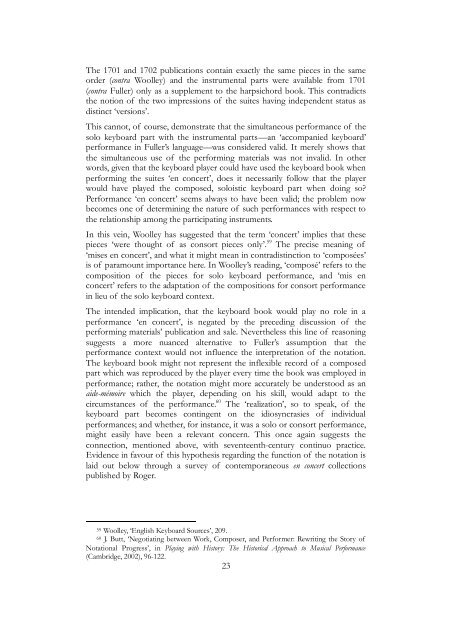Partiturbuch Ludwig - The Viola da Gamba Society
Partiturbuch Ludwig - The Viola da Gamba Society
Partiturbuch Ludwig - The Viola da Gamba Society
Create successful ePaper yourself
Turn your PDF publications into a flip-book with our unique Google optimized e-Paper software.
<strong>The</strong> 1701 and 1702 publications contain exactly the same pieces in the same<br />
order (contra Woolley) and the instrumental parts were available from 1701<br />
(contra Fuller) only as a supplement to the harpsichord book. This contradicts<br />
the notion of the two impressions of the suites having independent status as<br />
distinct ‘versions’.<br />
This cannot, of course, demonstrate that the simultaneous performance of the<br />
solo keyboard part with the instrumental parts—an ‘accompanied keyboard’<br />
performance in Fuller’s language—was considered valid. It merely shows that<br />
the simultaneous use of the performing materials was not invalid. In other<br />
words, given that the keyboard player could have used the keyboard book when<br />
performing the suites ‘en concert’, does it necessarily follow that the player<br />
would have played the composed, soloistic keyboard part when doing so?<br />
Performance ‘en concert’ seems always to have been valid; the problem now<br />
becomes one of determining the nature of such performances with respect to<br />
the relationship among the participating instruments.<br />
In this vein, Woolley has suggested that the term ‘concert’ implies that these<br />
pieces ‘were thought of as consort pieces only’. 59 <strong>The</strong> precise meaning of<br />
‘mises en concert’, and what it might mean in contradistinction to ‘composées’<br />
is of paramount importance here. In Woolley’s reading, ‘composé’ refers to the<br />
composition of the pieces for solo keyboard performance, and ‘mis en<br />
concert’ refers to the a<strong>da</strong>ptation of the compositions for consort performance<br />
in lieu of the solo keyboard context.<br />
<strong>The</strong> intended implication, that the keyboard book would play no role in a<br />
performance ‘en concert’, is negated by the preceding discussion of the<br />
performing materials’ publication and sale. Nevertheless this line of reasoning<br />
suggests a more nuanced alternative to Fuller’s assumption that the<br />
performance context would not influence the interpretation of the notation.<br />
<strong>The</strong> keyboard book might not represent the inflexible record of a composed<br />
part which was reproduced by the player every time the book was employed in<br />
performance; rather, the notation might more accurately be understood as an<br />
aide-mémoire which the player, depending on his skill, would a<strong>da</strong>pt to the<br />
circumstances of the performance. 60 <strong>The</strong> ‘realization’, so to speak, of the<br />
keyboard part becomes contingent on the idiosyncrasies of individual<br />
performances; and whether, for instance, it was a solo or consort performance,<br />
might easily have been a relevant concern. This once again suggests the<br />
connection, mentioned above, with seventeenth-century continuo practice.<br />
Evidence in favour of this hypothesis regarding the function of the notation is<br />
laid out below through a survey of contemporaneous en concert collections<br />
published by Roger.<br />
59 Woolley, ‘English Keyboard Sources’, 209.<br />
60 J. Butt, ‘Negotiating between Work, Composer, and Performer: Rewriting the Story of<br />
Notational Progress’, in Playing with History: <strong>The</strong> Historical Approach to Musical Performance<br />
(Cambridge, 2002), 96-122.<br />
23

















